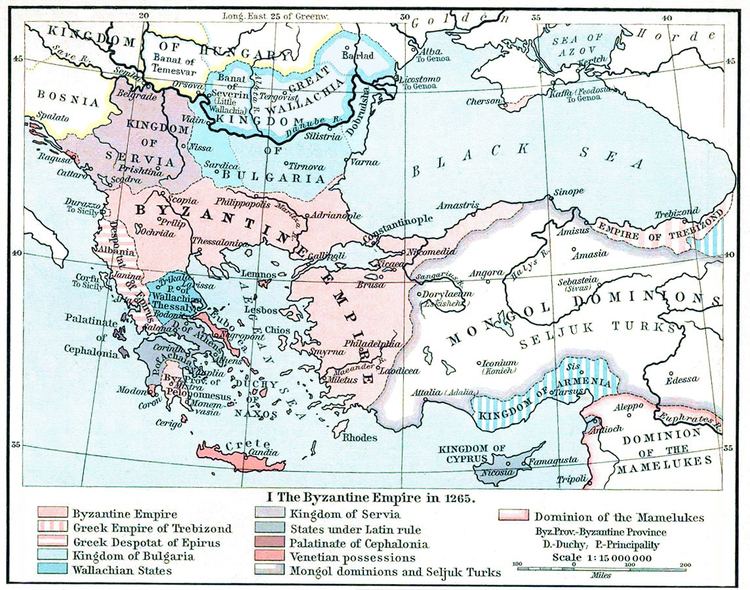Period May 1263 – July 1263 | Result Venetian victory | |
 | ||
32 galleys 38 galleys10 saettie(only 14 engaged) Similar Battle of Prinitza, Siege of Constantinople, Battle of the Echinades, Battle of Demetrias, Battle of Makryplagi | ||
Battle of settepozzi
The Battle of Settepozzi was fought sometime in May–July 1263 off Settepozzi (the Italian name for Spetses) between a Genoese-Byzantine fleet and a smaller Venetian fleet. The resulting Venetian victory had important political repercussions, as the Byzantines distanced themselves from their alliance with Genoa and restored their relations with Venice.
Contents
Background
In early July 1261, the Nicaean emperor Michael VIII Palaiologos (r. 1259–1261) had allied himself with the Genoese in the Treaty of Nymphaeum. This alliance, whose terms were very advantageous to Genoa, was necessary for the Nicaeans and their aim of successfully recovering Constantinople, the seat of the moribund Latin Empire. The Latin emperors were backed by the naval might of Venice (with whom Genoa was already at war), and without a strong navy to counter it, the city would not fall, as two previous attempts in 1235 and 1260 had demonstrated.
In the event, the city was recovered by Alexios Strategopoulos barely a fortnight after the treaty was signed, without the need for Genoese naval aid. For a year thereafter, both Venice and Genoa remained rather passive. Venice hesitated to confront the numerically far superior fleet that Genoa had dispatched in the Aegean and awaited political developments in the West, while Genoa suffered from internal turmoil with the deposition of the autocratic Captain of the People Marino Boccanegra and the assumption of power by a collective leadership from among the noble houses. In summer 1262, the Venetians ordered a 37-galley fleet into the Aegean, which met the Genoese fleet of 60 ships at Thessalonica, but the Genoese refused to engage. A piratical foray, however, by the nobles of Negroponte, allied with Venice, into the Marmara Sea was confronted and defeated by a Byzantine-Genoese squadron.
Battle
Meanwhile, hostilities broke out in the Morea, where Michael VIII dispatched an expeditionary force (in late 1262 or early 1263) against the Principality of Achaea. Despite initial successes, Byzantine attempts to conquer the entirety of the principality were decisively defeated at Prinitza and Makryplagi. In May–June 1263, a Byzantine-Genoese fleet of 38 or 39 galleys and 10 light cutters (saettie), sailing to the Byzantine fortress and naval base of Monemvasia in the southeastern Morea, encountered a Venetian fleet of 32 galleys sailing north to Negroponte.
The details of the engagement are not clear. The Genoese Annales Ianuenses claims that when the signal to attack was given, only fourteen Genoese ships advanced, while the rest stood back and then suddenly fled. The Venetian chronicler Canale, however, records that the Venetian ships attacked first, while the Genoese were trying to ambush them. The battle ended in a clear Venetian victory: the Genoese fleet, half of which failed to engage at all, lost many men, including an admiral and two of their flagships, before breaking off and fleeing. Canale claimed 1,000 Genoese losses as compared to 420 Venetian casualties. At any rate, the outcome was clearly the result of both the divided command of the Genoese fleet, and the reluctance, consistently displayed in earlier and later engagements, of the Genoese admirals to risk their ships: this was because the Genoese ships were fitted by private contractors, usually the rich noble merchants who ran the city, and thus constituted valuable assets for which the admirals were answerable.
Repercussions
Although most of the Genoese fleet survived the battle, their defeat had major political ramifications, as Michael VIII began to reconsider the alliance with Genoa, which was very costly but had so far brought little in return, chiefly due to the Genoese admirals' timidity. As a sign of his dissatisfaction, soon after the battle Michael VIII dismissed sixty Genoese ships from his service. The Byzantine-Genoese rift widened further in 1264, when the Genoese podestà in Constantinople was implicated in a plot to surrender the city to Manfred of Sicily, whereupon the emperor expelled the Genoese from the city. Michael signed a treaty with the Venetians on June 18, 1265, but it was not ratified by the Doge. In the face of the threat from Charles of Anjou after 1266, Michael was forced to renew his alliance with Genoa, but also maintained his détente with Venice, signing a five-year non-aggression pact in June 1268.
